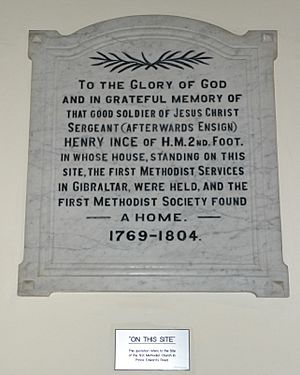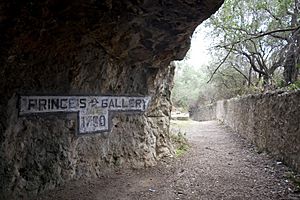Henry Ince facts for kids
Quick facts for kids
Henry Ince
|
|
|---|---|
| Born | 1736 Penzance, Cornwall |
| Died | 1808 (aged 71–72) Gittisham, Devon |
| Allegiance | United Kingdom |
| British Army | |
| Rank | Lieutenant |
| Unit | Soldier Artificer Company |
| Battles/wars | Great Siege of Gibraltar |
Henry Ince (1736–1808) was a brave soldier in the British Army. He started as a sergeant-major and later became a lieutenant. He became famous for his amazing idea to dig tunnels through the North Face of the Rock of Gibraltar in 1782. This happened during the Great Siege of Gibraltar.
Thanks to his hard work, by the end of the 1700s, Gibraltar had almost 4,000 feet (1,200 meters) of tunnels. These tunnels held many cannons that could fire down onto the land connecting Gibraltar to Spain. Henry Ince was one of the first members of the Soldier Artificer Company. This group was a very early version of today's Royal Engineers. He also helped start Methodism in Gibraltar as a lay preacher. Ince spent most of his life in the Army, serving 36 years in Gibraltar. He then retired to Devon, England, and passed away at age 72.
Contents
Henry Ince's Early Life and Army Service
Henry Ince was born in Penzance, Cornwall, in 1736. He first worked as a nail-maker, then as a miner. In 1755, he joined the army, specifically the 2nd (The Queen's Royal) Regiment of Foot. He served in Ireland for several years. In March 1768, his regiment was sent to Gibraltar. Here, Ince could use his mining skills, which became very important later.
He was also a very active Methodist lay preacher. This means he was a non-ordained minister who preached. He might have met John Wesley, a founder of Methodism, while Wesley was preaching in Ireland. In 1769, Ince wrote to Wesley from Gibraltar. He explained how he and a few others started a Methodist group there. They faced some difficulties from others, but their group grew.
The Governor of Gibraltar, Lieutenant General Edward Cornwallis, even issued an order to protect the Methodists. He said that no one should bother them or act badly in their meetings. According to local tradition, the first regular Methodist meeting place in Gibraltar was Ince's old home. A plaque at the modern Gibraltar Methodist Church mentions this. However, Ince's own letters suggest he rented a room for meetings, not his home.
Joining the Soldier Artificer Company
On June 26, 1772, Henry Ince joined the Army's first group of military builders and workers. This group was called the Soldier Artificer Company. On the same day, he was promoted to sergeant. Lieutenant Colonel William Green created this company. He wanted their help to improve Gibraltar's defenses.
The company had 68 men, including sergeants, corporals, and privates. These soldiers worked as stonecutters, masons, miners, carpenters, and more. Ince was one of the first two sergeants in the company.
Seven years later, the Great Siege of Gibraltar began. French and Spanish armies surrounded Gibraltar. This became the longest siege a British army had ever faced. The Soldier Artificer Company worked tirelessly. They repaired damage from enemy bombs and made Gibraltar's defenses stronger. They also took part in a successful surprise attack against the Spanish lines in 1781. The new Governor, General George Eliott, praised their efforts.
Building Gibraltar's Siege Tunnels
The Spanish slowly moved closer to Gibraltar by digging trenches. This made it harder for the British to aim their cannons down at the enemy. The steep cliff of the North Front of the Rock of Gibraltar limited where cannons could be placed. By May 1782, many British cannons on the North Front were out of action.
General Eliott offered a reward of 1,000 Spanish dollars. He wanted an idea to get cannons to fire sideways at the enemy's positions. Henry Ince, who had been promoted to Sergeant-Major, had a brilliant idea. He suggested digging a tunnel through the Rock itself. This tunnel would lead to a spot called the Notch. A cannon placed there could cover the entire North Front.
His idea was quickly approved. On May 22, 1782, Colonel Green ordered the work to begin. Twelve miners, led by Sergeant-Major Ince, started digging a tunnel. It was planned to be 6 feet high and 6 feet wide.
How the Tunnels Were Dug
Digging the tunnels began on May 25, 1782. All the work was done by hand. The miners broke up the limestone rock in several ways:
- They used gunpowder to blast the rock.
- They built fires against the rock face to heat it, then poured cold water on it to make it crack.
- They used quicklime in boreholes. When water was added, it expanded and shattered the rock.
- They hammered wooden wedges into cracks and soaked them with water. The expanding wood would break the rock.
After breaking the rock, they removed the pieces with crowbars and sledgehammers. The work was slow, but the tunnels they dug were very strong. They are still open today.
The miners had poor air inside the tunnels. So, they decided to blast a small opening in the cliff for fresh air. They quickly realized this opening would be a perfect spot for a cannon! By the end of the siege, this new Upper Gallery had four guns. These guns were on special "depressing carriages" that let them fire downwards. The original target, the Notch, was reached after the siege ended. Instead of a gun above it, the area was hollowed out for a wide firing position.
It's not clear if Ince received the 1,000-dollar reward. However, a story says he got one guinea for every foot of tunnel dug. This would have been a lot of money! By the end of the siege in 1783, the main tunnel, the Windsor Gallery, was 500 to 600 feet long. When the French general, the Duc de Crillon, visited the tunnels, he was very impressed. He reportedly said, "These works are worthy of the Romans."
Tunnelling continued after the siege, with Ince supervising. By 1799, the tunnels were nearly 4,000 feet (1,200 meters) long. They were built on two levels: the Upper (or Windsor) and Lower (or Union) Galleries. These tunnels held about 40 heavy cannons, along with ammunition storage and bombproof shelters. Today, the Upper Galleries are a popular tourist attraction called the Great Siege Tunnels.
Later Years and Retirement
In January 1787, Henry Ince was given a piece of land on the Queen's Road in Gibraltar. This area is still known as Ince's Farm. During the siege, he had already started farming it with the Governor's permission. He paid a small rent and had to build a fence and plant many lemon trees. His lease was renewed in 1803 because of his excellent service. Later, this farm became a storage area for the Royal Engineers, the successors to the Soldier Artificers.
Ince left the Soldier Artificer Company in 1791. However, he continued to work on the tunnels as the "overseer of the mines." This meant he was in charge of blasting, mining, and building new cannon positions. He became an ensign in 1796 and a lieutenant in 1801. He was known as an "active, prompt, and persevering" man. He was short but strong and well-liked by his officers.
There's a story about Ince and Prince Edward, Duke of Kent and Strathearn. The Prince supposedly offered Ince a new horse to replace his old one. But Ince kept riding his old horse. When asked why, Ince said he couldn't handle such a lively animal. The Prince then told him to "put him into your pocket!" Ince understood this meant he should sell the horse, which he did for a good amount of money.
Henry Ince returned to England in 1804. He passed away on October 9, 1808, in Gittisham, Devon. His gravestone, which was later fixed up by the Institution of Royal Engineers, praises his skill and hard work on the Gibraltar fortress. It says he served his Majesty for 49 years and died "full of honor."
|






